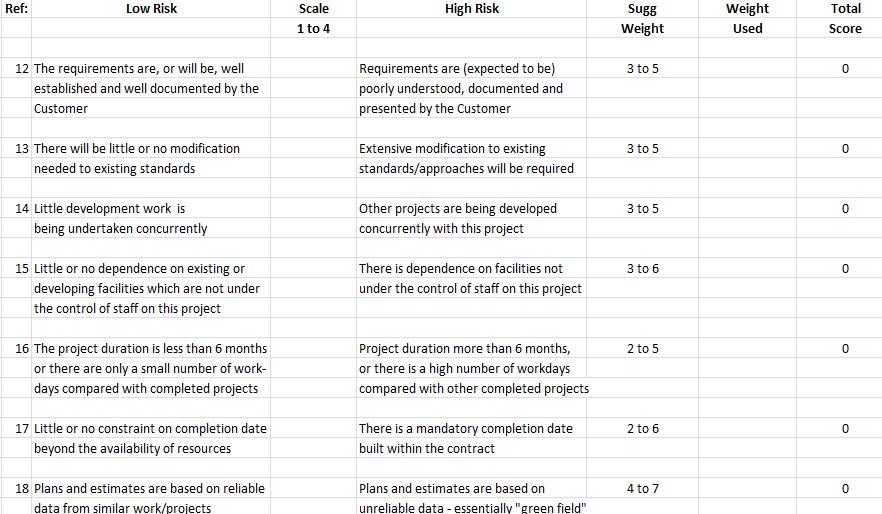Project Risk Assessment Form Template
Sponsored Link高级模板 保存,填空,打印,三步搞定!

下载 下载 Looking for an easy-to-use Project Risk Assessment Form? What are the steps involved in writing a risk assessment? our sample form and get started today!
只有今天: USD 2.49
点击购买

可用的免费文件格式:
微软电子表格 (.xls)- 本文档已通过专业认证
- 100%可定制
- 这是一个数字下载 (197.5 kB)
- 语: English
- 付款完成后,您将收到包含该文件的电子邮件。
Sponsored Link
Looking for an easy-to-use Project Risk Assessment Form? What are the steps involved in writing a risk assessment? Our Project Risk Assessment Form is designed to help you quickly assess the risks associated with a project. It includes a comprehensive checklist of items and an easy-to-use scoring system. Download this form and get started today.
A Project Risk Assessment Form is a structured document or tool used by project managers and teams to identify, evaluate, prioritize, and manage risks associated with a specific project. It is an essential component of project risk management and helps ensure that potential risks are systematically analyzed and addressed throughout the project's lifecycle.
Here are the key elements typically included in a Project Risk Assessment Form:
- Project Information: This section includes basic project details such as the project name, description, start date, end date, and the names of project stakeholders.
- Risk Identification: This is where project team members brainstorm and list all potential risks that could impact the project. Risks can be categorized as internal (related to the project itself) or external (related to external factors such as market conditions or regulatory changes). Common risk categories might include scope, schedule, cost, technology, and more.
- Risk Description: Each identified risk is described in detail, including its potential impact on the project's objectives, its likelihood of occurrence, and any contributing factors or root causes.
- Risk Analysis: This involves assessing the severity or consequences of each risk and its likelihood of occurring. Typically, a numerical scale or a qualitative assessment (e.g., low, medium, high) is used to rank risks based on their potential impact and probability.
- Risk Prioritization: Risks are prioritized based on their analysis results. High-priority risks are those with the greatest potential impact and likelihood of occurrence and should receive more attention and resources in terms of mitigation and monitoring.
- Risk Mitigation: This section outlines specific strategies and actions to reduce or eliminate the identified risks. It includes plans for risk avoidance, risk transfer, risk reduction, and contingency plans if the risk materializes.
- Responsibility: Assign specific team members or stakeholders responsible for implementing and monitoring risk mitigation strategies.
- Monitoring and Review: Describe how the project team will continuously monitor and review the identified risks throughout the project's life cycle. This may include regular risk review meetings, status reports, and updates to the risk assessment form.
- Documentation: Ensure that all changes to the risk assessment, as well as any actions taken to address risks, are documented for future reference and for auditing purposes.
- Sign-off: Obtain approval and sign-off from relevant stakeholders, including the project sponsor and senior management, to acknowledge their awareness and acceptance of the identified risks and the proposed mitigation strategies.
Project Risk Assessment Forms are dynamic documents that evolve as the project progresses. They provide a structured framework for proactive risk management and help project teams stay informed and prepared to deal with potential challenges. Regularly updating and revisiting the form ensures that new risks are identified and that mitigation strategies remain relevant throughout the project's life cycle.
We provide a thorough and professional Risk Assessment Template in Excel, also known as: 'Project Risk Assessment Template'. The form contains 37 project management questions, with a variation of 1 to 4 and also a suggested 'weight factor' to calculate your risks.
The risk factors, i.e. those which affect the probability that the project will be completed on time and within the agreed contract/budget, and will deliver a quality-compliant End Product, arise from the following six sources:
- Project Management
- Project Staff
- Nature Of Project
- Maturity of the Organisation (Internal and Third Party Suppliers)
- Customer and Contract
- Third-Party Supplier
The risks associated with each of these elements are itemized and estimated below in the form of statements typifying low and high risk, on either side of a scale of 0.1 to 4.0. The assessed risk under column (b) has been multiplied by the weighting factor inserted in column (e) to provide a total score for each risk factor identified. On a separate Excel tab, you can find the Risk Analysis sheet that shows the "Consequences" and "Likelihood".
Our project management templates in Excel are all screened by project professionals. Download this project risk assessment template to professionalize your way of communication and to save time, costs, or effort!
Download this Project Risk Assessment template Excel template and after downloading you can craft and customize every detail and its appearance very quickly.
Check this link for more Risk Assessment Templates!
DISCLAIMER
Nothing on this site shall be considered legal advice and no attorney-client relationship is established.
发表评论。 如果您有任何问题或意见,请随时在下面发布
相关文件
Sponsored Link
